Name Chaolung Sukaphaa Reign 1228–1268 Died 1268Charaideo | Coronation 2 December 1228 | |
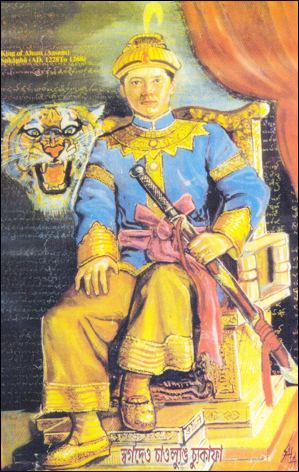 | ||
Tai AHOM song ♧ Tribute to Chaolung Sukaphaa Siu-Ka-Pha ◇ Ahom dynasty Assam
Chaolung Sukaphaa (r. 1228 – 1268), also Siu-Ka-Pha, the first Ahom king in medieval Assam, was the founder of the Ahom kingdom. A Tai prince originally from Mong Mao, (which is now included within the Dehong-Dai Singhpho Autonomous Prefecture of Yunnan in Peoples Republic of China), the kingdom he established in 1228 existed for nearly six hundred years and in the process unified the various tribal and non-tribal peoples of the region that left a deep impact on the region. In reverence to his position in Assam's history the honorific Chaolung is generally associated with his name (Chao: lord; Lung: great).
Contents
- Tai AHOM song Tribute to Chaolung Sukaphaa Siu Ka Pha Ahom dynasty Assam
- go Chaolung Sukaphaa Memorial go HYPERLAPSE
- Legend
- Prince of Mong Mao
- The search for a Kingdom
- Journey into Assam
- King of Ahom kingdom
- Search for a capital
- Memorial
- References
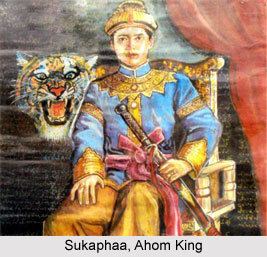
Since 1996 December 2 has been celebrated in Assam as the Sukaphaa Divas, or Asom Divas (Assam Day), to commemorate the advent of the first king of the Ahom kingdom in Assam after his journey over the Patkai Hills. He is also known as the first Assamese.
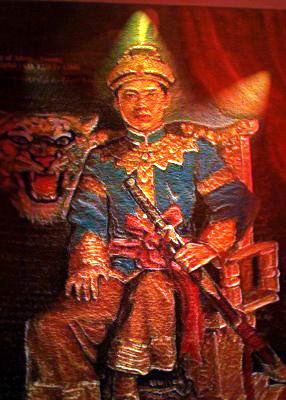
go Chaolung Sukaphaa Memorial go | HYPERLAPSE
Legend
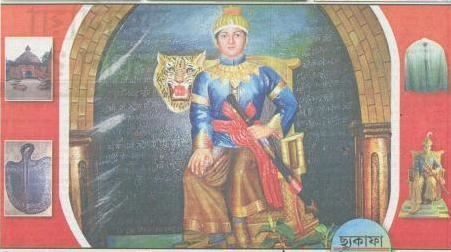
According to Ahom tradition, Sukaphaa was a descendant of the god Khunlung, who had come down from the heavens and had ruled Mong-Ri-Mong-Ram. During the reign of Suhungmung, which saw the composition of the first Assamese chronicles and increased Hindu influence, Sukaphaa's origin was traced to the union of god Indra (identified with Khunlung) and Syama (a low-caste woman), and he was declared the progenitor of the Indravamsa kshatriyas, a lineage created for the Ahoms by the Hindu Brahmins.
Prince of Mong Mao
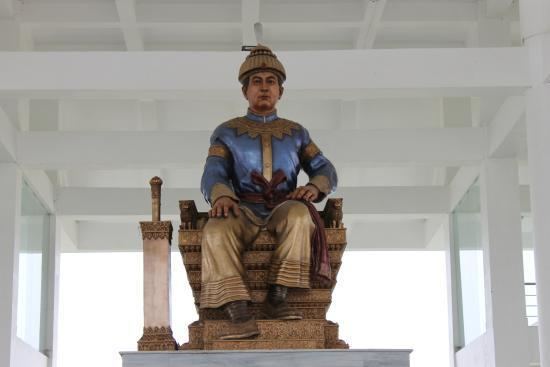
The details of Sukaphaa's life and origins before his entry into Assam, available from different chronicles, both Ahom and non-Ahom, are full of contradictions. According to Phukan (1992) who has tried to hold up a consistent account, Sukaphaa was born to Chao Chang-Nyeu (alias Phu-Chang-Khang) and Nang-Mong Blak-Kham-Sen in the Tai state of Mong Mao (also called Mao-Lung, with the capital at Kieng Sen), close to present-day Ruili in Yunnan, China. Chao Chang Nyeu was a prince from Mong-Ri Mong-Ram, who had traveled to Mong Mao possibly on an expedition. Mong Mao was then ruled by Chao Tai Pung. Chao Chang Nyeu was later befriended by Pao Meo Pung, the son of the ruler, who gave his sister Blak Kham Sen in marriage. Sukaphaa was born of this union not later than 1189 and was brought up by his maternal grandparents. Pao Meo Pung, who eventually ruled Mong Mao, had no male heir and Sukaphaa, his nephew, was nominated to succeed him. A son born late to Pao Meo Pung's queen ended Sukaphaa's claim to the throne of Mong Mao.
The search for a Kingdom
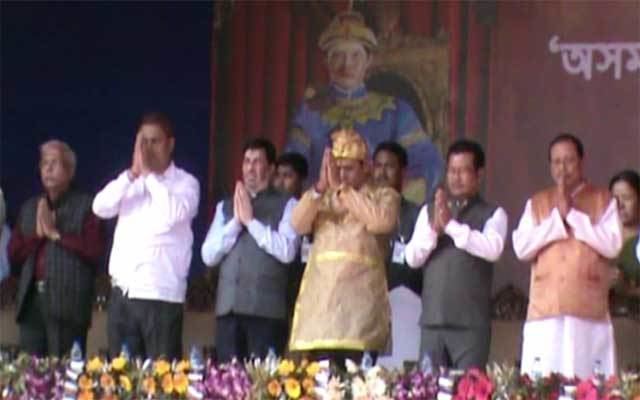
After his 19 years as crown prince came to an end Sukaphaa decided to leave Mong Mao. According to tradition, his grandmother advised him thus - "no two tigers live in the same jungle, no two kings sit on the same throne." Accordingly Sukaphaa is said to have left Chieng-Sen the capital of Mong Mao in the year 1215 AD.
Journey into Assam
Sukaphaa left Mong Mao in 1215. He was accompanied by three queens, two sons and a daughter; chiefs from five other dependent Mongs; members of the priestly class and soldiers—a total contingent of 9,000. Some commoners are recorded as having joined this core group on the way. Sukaphaa had with him 300 horses fitted with saddles and bridles and two elephants. Heavy arms were transported along a different route. Sukaphaa followed an older known route from Yunnan to Assam that passed through Myitkyina, Mogaung and the upper Irrawaddy river valley. On his way he stopped at various places and crossed the Khamjang river to reach the Nangyang lake in 1227. Here he subjugated the Nagas very ferociously and established a Mong. He left one Kan-Khrang-Mong there to guard the passage back, and proceeded to cross the Patkai hills at the Pangsau pass and reached Namrup (in the Brahmaputra valley) in December 1228. The journey, from Mong Mao to Namrup thus took Sukaphaa about thirteen years and the year he reached Namrup is considered as the year the Ahom kingdom was established.
King of Ahom kingdom
Having reached Namrup, Sukaphaa bridged the Sessa river, and went upstream along the Burhi Dihing river looking to establish a colony for wet rice cultivation. He did not find the region conducive to cultivation and returned downstream to Tipam. In 1236, he left Tipam for Abhaypur. A flood made him move again in 1240 down the Brahmaputra to Habung (present-day Dhakuakhana). Another flood and he moved again in 1244, down the Brahmaputra to the Dikhowmukh, and then up the Dikhow river to Ligirigaon. Leaving a detachment at Ligirigaon, he moved again in 1246 to Simaluguri. In 1253, he abandoned Simaluguri for Charaideo, his final capital, where he finally died in 1268.
Even though Sukaphaa treated the people of the Patkai hills very severely on his way to the Brahmaputra valley, his approach to the population in Assam was conciliatory and non-confrontational. He married the daughters of Badaucha, the Matak Chief and Thakumatha, the Barahi chief and established cordial relations with them. As he began establishing his domain, he avoided regions that were heavily populated. He encouraged his soldiers as well as members of the Ahom elite to marry locally. A process of Ahomization (whereby locals who adopted Ahom methods of wet rice cultivation and statecraft were accepted into the Ahom fold) bolstered the process of integration. The Barahi and the Moran, speakers of Tibeto-Burman languages, called Sukaphaa's people "Ha-Cham", that later on developed into "Assam" (see Etymology of Assam), the name of the kingdom; and "Ahom", the name of the people.
Search for a capital
Over the next few years, he moved from place to place searching for the right capital, leaving behind his representative at each stage to rule the colonized land. Then he went up the Burhidihing river and established a province at Lakhen Telsa. Then he came back down the river and established his rule at Tipam. In 1236 he moved to Mungklang (Abhoipur), and in 1240 down the Brahmaputra to Habung (Dhemaji). In 1244 he went further down to Ligirigaon (Song-Tak), a few miles from present-day Nazira, and in 1246 to Simaluguri (Tun Nyeu), a place downstream from the present-day Simaluguri. Sukaphaa then remained in Demow for six years. Finally in 1253 he built himself his capital city at Charaideo near present-day Sibsagar town. The capital of the Ahom kingdom changed many times after this, but Charaideo remained the symbolic center of Ahom rule.
With the help of local recruits, he established three large farms for sali rice cultivation, called Barakhowakhat, Engerakhat and Gachikalakhat.
In 1268 Sukaphaa died. At the time of his death, his kingdom was bounded by the Brahmaputra River in the west, the Burhidihing River (27°19′27″N 95°07′11″E) in the north, the Dikhow River (26°58′15″N 94°38′12″E) in the south and the Naga Hills in the east.
